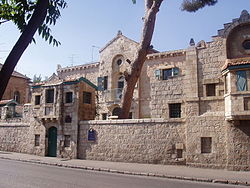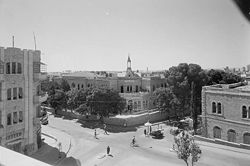- Conrad Schick
-
Conrad Schick (1822–1901) was a German architect, archaeologist and Protestant missionary who settled in Jerusalem in the mid-nineteenth century.[1]
Contents
Biography
Conrad Schick was born in Bitz, Württemberg, Germany. At the age of 24, after completing his studies in Basel, he settled in Palestine in October 1846.[2] The Reformed St. Chrischona Pilgrim Mission (German: Pilgermission St. Chrischona) at Bettingen sent him out as missionary.[3]
The house that Schick built for his family, Tabor House, or Beit Tabor, on Jerusalem's Street of the Prophets, is still standing.[4] The name of the house is based on a verse from Psalms (89:12): "The north and the south, Thou has created them; Tabor and Hermon shall rejoice in Thy name." The facade is decorated with carvings of palm leaves and the Greek letters Alpha and Omega, symbolizing the beginning and the end.[5]
When Schick died in Jerusalem in 1901, he was mourned by Jews, Muslims and Christians alike. He was buried in the Protestant cemetery on Mount Zion.[6] The house was bought in 1951 by Swedish Protestants, and now houses Swedish Theological Institute for religious instruction and Land of Israel studies.[5]
Architecture and archaeology
Schick was chosen to design Mea Shearim, one of the first neighborhoods in Jerusalem built outside the walls of the Old City. Schick is chiefly remembered for his fifty years of archaeological investigations of Jerusalem and its surroundings. He worked for many years for the Palestine Exploration Fund, publishing frequently in the Fund's journal.[7] In 1872, Schick was permitted to conduct research on the Temple Mount, which was generally off limits to foreigners. Two wooden models he built were exhibited in the Turkish pavilion at the Vienna World Exposition of 1873. One was later sold to a museum in Switzerland.[8] King Charles I of Württemberg bought the other and subsequently raised Schick to the rank of Royal Württembergian Hofbaurat (Privy Construction Councillor) for his excellent work.[9]
In 1887, Schick designed the Unity of the Brethren lepers' hospital Jesushilfe, since 1885 led by his son-in-law Dr. Adalbert Einsler (1848–1919), a landmark building (today's Hansen Government Hospital for Lepers) that can still be seen today near the Jerusalem Theater in Talbiya.[8] Other buildings designed by Schick are St. Paul's Anglican Chapel and the German Deaconesses Hospital (today the eastern wing of Bikur Holim Hospital), both on Street of the Prophets.[10]
Biblical models
Schick constructed a notable series of Replicas of the Jewish Temple. His replica of the biblical Tabernacle was visited in Jerusalem by several crowned heads of state, toured the United Kingdom, and exhibited at the 1873 Vienna World's Fair. It was purchased by the King of Württemberg, who awarded Schick a knighthood in recognition of his work. Schick built a replica of the Temple Mount and Dome of the Rock for the Ottoman Sultan. His final model, in four sections, each representing the Temple Mount as it appeared in a particular era, was exhibited at the St. Louis World's Fair of 1904.[11]
Two models of the Temple Mount created by Schick are located in the basement of the Schmidt School for Girls on Nablus Road, just outside of the Old City of Jerusalem near the Damascus Gate. One model shows the Temple Mount as it was in the 1870s, based on his research. The other is a somewhat fanciful model of the Jewish Temple.
Commemoration
The Conrad Schick Library in the Old City of Jerusalem is named for him.[12]
References
- August Strobel, Conrad Schick: ein Leben für Jerusalem; Zeugnisse über einen erkannten Auftrag, Fürth: Flacius-Verlag, 1988. ISBN 3-924022-18-6 (German)
Notes
- ^ British mission to the Jews in nineteenth-century Palestine, by Yaron Perry, Routledge, 2003, p. 110
- ^ Remembering Conrad Schick
- ^ August Strobel, Deine Mauern stehen vor mir allezeit: Bauten und Denkmäler der deutschen Siedlungs- und Forschungsgeschichte im Heiligen Land, Gießen: Brunnen, 1998, (= Biblische Archäologie und Zeitgeschichte; vol. 7), p. 65. ISBN 37655-9807-0
- ^ Rehov Hanevi'im - Around the houses, Jerusalem Post
- ^ a b Jerusalem architecture
- ^ British mission to the Jews in nineteenth-century Palestine, Yaron Perry, Routledge, 2003, p. 110
- ^ Measuring Jerusalem: the Palestine Exploration Fund and British interests in the Holy Land, John James Moscrop, Continuum International Publishing Group, 2000, p. 101
- ^ a b Life of Conrad Schick
- ^ August Strobel, Conrad Schick: ein Leben für Jerusalem; Zeugnisse über einen erkannten Auftrag, Fürth: Flacius-Verlag, 1988, p. 44. ISBN 3-924022-18-6
- ^ Christian architecture in Jerusalem
- ^ Simon Goldhill, The Temple of Jerusalem, Harvard University Press, p. 129
- ^ Rare books library
External links
Categories:- German architects
- Holy Land archaeologists
- History of Jerusalem
- 1822 births
- 1901 deaths
- Burials at Mount Zion (Protestant)
Wikimedia Foundation. 2010.



